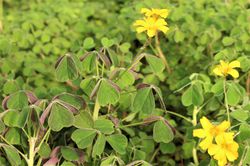 In two separate articles we have presented the new tuberous vegetable species Oca (Oxalis tuberosa) and also the production of young plants for retailers. Here now we will portray the three current varieties in the Lubera Edibles young plant range for professional growers. As with potato and also sweet potato, our sister company Lubera AG is active in the development of new varieties.
In two separate articles we have presented the new tuberous vegetable species Oca (Oxalis tuberosa) and also the production of young plants for retailers. Here now we will portray the three current varieties in the Lubera Edibles young plant range for professional growers. As with potato and also sweet potato, our sister company Lubera AG is active in the development of new varieties.
Oca 'Tubered®' – the bright red oca
The variety Tubered® has completely red-coloured tubers and also a certain amount of anthocyanins in the leaves and shoots, which is noticeable due to the reddish leaves and shoots, thus also providing a certain ornamental value. This red skin is retained during baking/roasting, but is lost to a large extent during cooking. When enjoyed raw, Tubered® has a lemony, tart flavour that mellows during both cooking and baking.
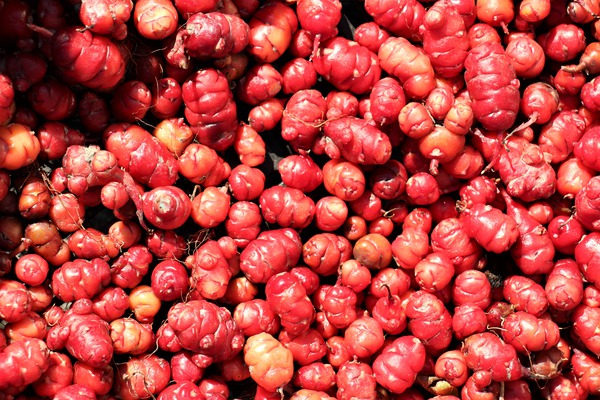
Picture: the red tubes from oca 'Tubered'
Short description – Oca 'Tubered®'
- Harvest: as late as possible, from the end of October/beginning of November
- Tubers: bright red, elongated, cone-shaped
- Taste: fresh, lemony, acidic flavour
- Growth: up to 40 cm high, one plant can cover up to 0.7 m²
- Use: the best variety for baked chips, retains the red colour of the peel
Oca 'Tuberello®' – the bright yellow oca (H2)
The Tuberello® variety has bright yellow tubers. Even with the yellow tubers, the colour of the skin is largely lost during cooking. It seems that Tuberello® is not as sensitive to temperature during the summer as the other varieties and as a result, individual plants can cover up to 1m². In terms of taste, Tuberello® is the variety with the mildest acidity and no earthy aftertaste.
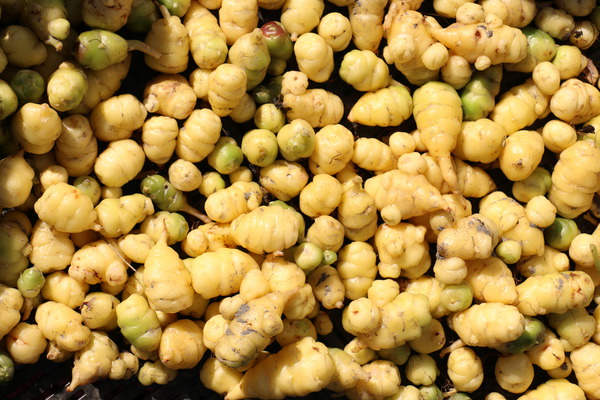
Picture: the yellow tubes from oca 'Tuberello'
Short description – Oca 'Tuberello®'
- Harvest: as late as possible, from the end of October/beginning of November
- Tubers: bright yellow, elongated, cone-shaped
- Taste: a fine, moderate acidity, without an earthy aftertaste
- Growth: up to 40 cm high, does not seem to be as sensitive to temperature as the other varieties
- Use: for eating fresh, but also for baking as well as cooking, recommended for puree
Oca 'Tuberosa®' – the oca with the largest tubers
The variety Tuberosa® forms the largest tubers of all the varieties. In addition, the tubers have a particularly striking colouration. The base colour is bright red, paired with creamy white eyes. The colour of the tubers is also reflected in the shoots, which have a pinkish red colour. In the summer, Tuberosa® predominantly stops growing, but starts to grow again in autumn.
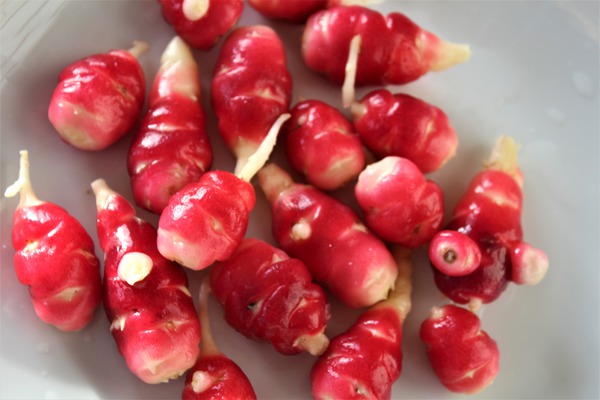
Picture: the colourful tubes from oca 'Tuberosa'
Short description – Oca 'Tuberosa®'
- Harvest: as late as possible, from the end of October/beginning of November
- Tubers: forms the largest tubers, striking colour: bright red with creamy white eyes
- Taste: sour with a slightly earthy aftertaste, which disappears during cooking/baking
- Growth: up to 40 cm high, one plant can cover up to 0.7 m²
- Use: For eating fresh, but also for baking as well as cooking, recommended for puree
Oca breeding at Lubera
We are currently testing a number of other oca varieties at Lubera and have also recently started to develop new varieties in a smaller breeding project. In this process, the production of crosses and the harvesting of seeds alone pose a great difficulty, as flower formation – if at all – only occurs in the short day photoperiod, and seeds rarely mature under normal conditions. Nevertheless, we are making progress in this area as well and are now in the process of testing larger populations of oca seedlings. In addition to the external and very diverse colour of the tubers and tuber size, we are also focusing on the flesh colour: here, our goal is also to develop varieties that offer red flesh and an even fruitier taste. Above all, we are trying to find varieties that can tolerate more heat in the summer in our (warmer) Central European climate (i.e. that can be grown not only in partial shade) and that start tuber formation earlier. Let's not forget where the oca comes from, which is near the equator and there is actually always a day length of +/- 12 hours here. The oca can thus form tubers much earlier and also bring higher yields than in our region. The same difficulty, namely to make a long-day plant out of a 12-day plant (in our case a short-day plant), was also encountered several hundred years ago when acclimatising the potato to our climatic conditions. So there is still a lot of breeding work waiting for us. But even the current varieties can already enrich our tuber plant and assortment of storable vegetables with new colours and a fruity, sour taste.
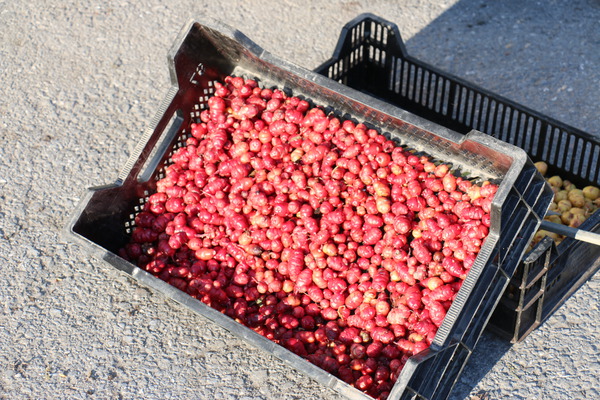
Picture: Yield recording of new varieties after trial cultivation
More oca articles
Read our other article about this interesting tuber vegetable.
Oca tubers (Oxalis tuberosa) – a plant portrait of the colourful Andean tubers
